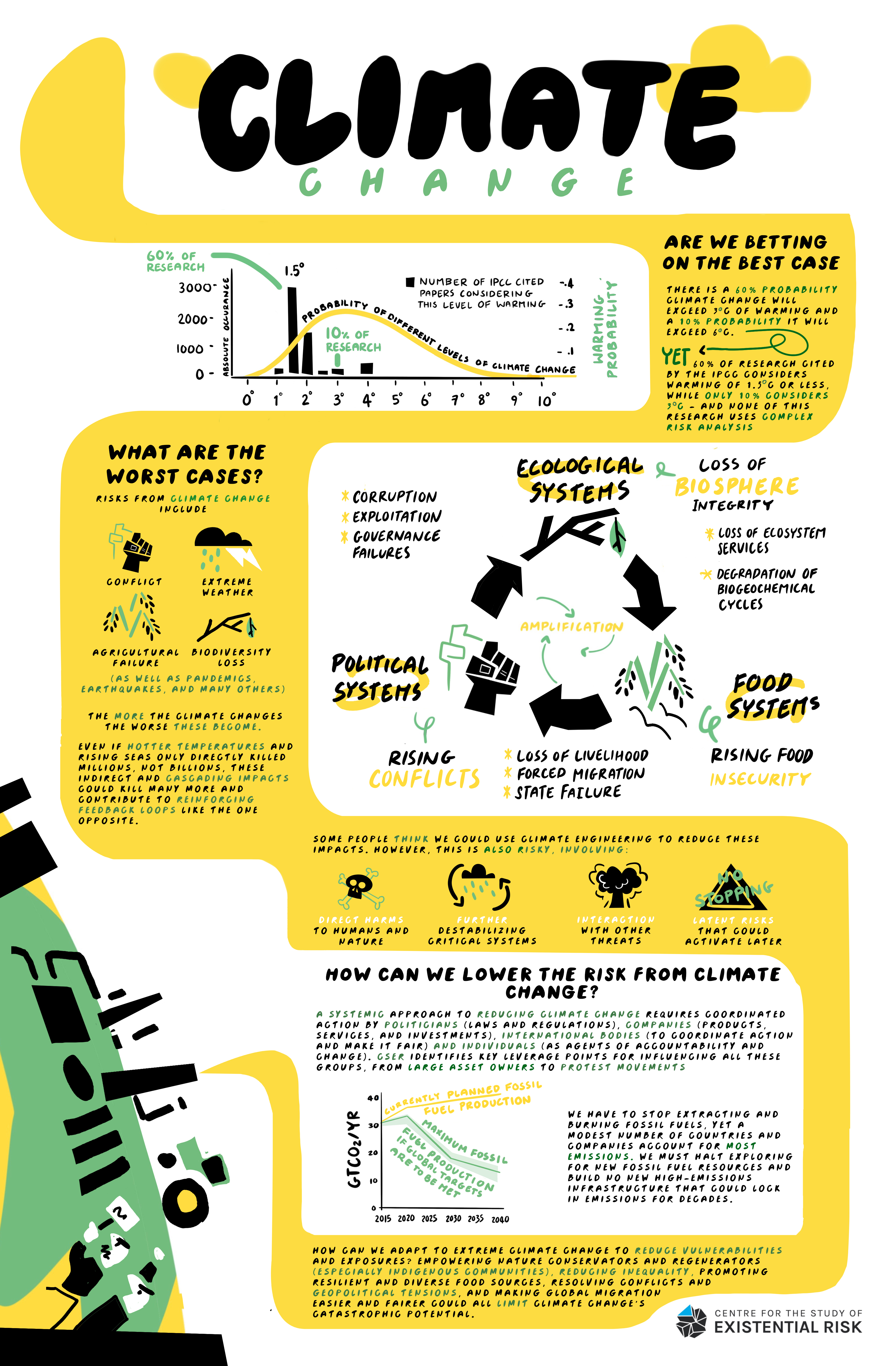
This infographic summarizes some of CSER’s research and advocacy work around the existential and globally catastrophic potential of climate change, as a risk driver, risk multiplier, and risk mitigation opportunity.
The first section, Are We Betting on the Best Case? Largely draws on Betting on the best case: higher end warming is underrepresented in research a study by Luke Kemp and others that compared the probability of different warming rates to their mentions in IPCC reports through text mining.
The second section, What are the Worst Cases? Build’s on a number of studies that CSER researchers have undertaken into understanding catastrophic climate risk. Assessing Climate Change’s Contribution to Global Catastrophic Risk, by SJ Beard and many CSER colleagues, applied a range of tools from Existential Risk Studies to produce a conceptual framework for understanding climate risk, illustrated by the "Global Systems Death Spiral" shown here. Re-framing the threat of global warming: an empirical causal loop diagram of climate change, food insecurity and societal collapse, by Catherine Richards and others, identifies an empirical evidence base of climate change, food insecurity and societal collapse in contemporary society and then structure it using a novel-format causal loop diagram. Climate Endgame: Exploring catastrophic climate change scenarios, brought together a wide coalition of environmental scientists, global systems experts, and existential risk researchers to call on the IPCC to produce a dedicated report into catastrophic climate change and set out a research agenda for what this should include. Finally A Fate Worse Than Warming? Stratospheric Aerosol Injection and Global Catastrophic Risk by CSER Research Affiliate Aaron Tang with Luke Kemp assessed the risk from Stratospheric Aerosol Injection, an potential geoengineering technology that has been advocated as a potential risk mitigation strategy for some of climate change’s negative effects. The paper assesses this technology’s potential contribution to global catastrophic risk across four interrelated dimensions:
- Acting as a direct catastrophic risk, through potentially unforeseen ecological blowback;
- Interacting with other globally catastrophic hazards, like nuclear war;
- Exacerbating systemic risk, which cascade and amplify across different systems;
- Acting as a latent risk, which is dormant but can later be triggered such as carrying potentially catastrophic implications if we were ever to stop using it, known as termination shock.
In addition to these broad studies CSER researchers have also produced a range of more focused studies into specific links in the kinds of casading catastrophe that we believe should concern us most, such as A System Dynamics Perspective of Food Systems, Environmental Change and Global Catastrophic Risks (on the connections between food security and environmental change) and Governance explains variation in national responses to the biodiversity crisis (on the connections between social stability and ecological collapse).
The final section How Can we Lower the Risk from Climate Change? draws on a wide variety of CSER’s efforts to not only understand catastrophic climate risk but also to mitigate it. A key insight that has influenced CSER’s work in this area is the need to identify key leverage points to produce the strongest responses across the entire human system, as described by CSER’s scientific advisor Doyne Farmer in Sensitive intervention points in the post-carbon transition. We have applied this philosophy across a wide range of climate mitigation interventions, including divesting large institutions from fossil fuels and helping large asset owners be better stewards of environmental resources, helping inform policy discussions around geoengineering research, establishing new institutions to promote longterm political thinking, working with religious leaders, and feeding into public discussions via media appearances, podcasts, and popular articles.
CSER also seeks to broaden the discussion about climate change mitigation to ensure that potentially vital strategies are not missed. For instance Natalie Jones has contributed to the Production Gap Report, whose work on identifying fossil fuel production (alongside consumption) as a key driver of climate change is illustrated in this section. Several of the paper we have already cited also discuss the important question of whether we can reduce humanity and the biospheres vulnerability and exposure to catastrophic climate risk and this is also a question we have explored in relation to other topics such as alternative food sources and even the potential to decouple humanity from the biosphere. However it is important to note that, unlikely several other drivers of global catastrophic and existential risk, this strategy may be less effective than direct mitigation of the hazard we are imposing on ourselves by anthropogenic climate change.
The depth and breadth of CSER’s work on different aspects of climate change makes it impossible to encapsulate everything that we do in a simple infographic. For more information see our recent statement on the IPCCs latest assessment report and feel free to make contact with us if you would like to know more or to work with us on developing this important work.